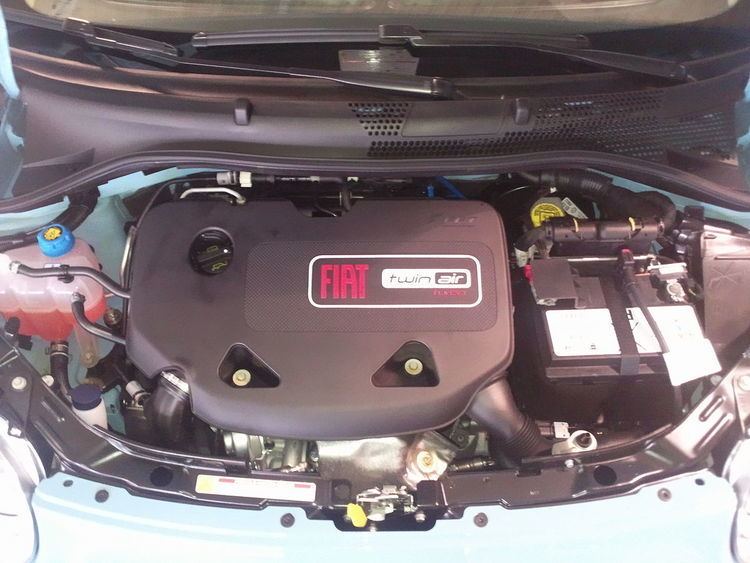 | ||
Multiair is a hydraulically-actuated variable valve timing (VVT) engine technology enabling "cylinder by cylinder, stroke by stroke" control of intake air directly via a gasoline engine's inlet valves. Developed by Fiat Powertrain Technologies, the technology bypasses a primary engine inefficiency: pumping losses caused by restriction of the intake passage by the throttle plate, used to regulate air feeding the cylinders. Multiair was licensed to the Schaeffler Group in 2001, which also markets the system as Uniair.
Contents
FCA, at the time Fiat S.p.A., launched Multiair in 2009 employing a proprietary electro-hydraulic system to precisely control air intake without a throttle valve, in order to increase engine power and torque, reduce fuel consumption, reduce emissions — and improve engine operation — offering "a more controllable flow of air during the combustion cycle in comparison with mechanical VVT systems." The technology allows engines to be lighter and smaller while reducing pumping losses — and can be adapted to existing engines by replacing the camshaft with the Multiair system.
Compatible with both naturally aspirated and forced-induction engines, Multiair technology was patented by Fiat in 2002 and was launched at the 2009 Geneva Motor Show in the Alfa Romeo MiTo. Marketed prominently in Fiat's FIRE engines, e.g., in the Fiat 5002007, Multiair engines for global markets are manufactured in Termoli, Italy at the Fiat Powertrain Technologies factory and at the FCA's Dundee Engine Plant (formerly of Global Engine Alliance's GEMA manufacturing branch), with critical systems manufactured and assembled by Schaeffler Group.
In 2010, the 1.4L Multiair engine won the International Engine of the Year as well as Popular Science's Best of What's New. The Fiat TwinAir 875 cc two-cylinder engine, also using Multiair technology, was named Best New Engine of 2011.
Technology
For variable valve timing, competing technologies (e.g., Honda's VTEC and BMW's VANOS) use electromechanical concepts, achieving valve lift variation via dedicated mechanisms, usually combined with camshaft phasers to allow control of both valve lift and phase. In contrast, Multiair uses managed hydraulic fluid to provide variable valve control.
Control of a Multiair engine's intake valves works via a valve tappet (cam follower), moved by a mechanical intake cam, which is connected to the intake valve through a hydraulic chamber, controlled by a normally open on/off solenoid valve. The system allows optimum timing of intake valve operation.
MultiAir technology can increase power (up to 10%) and torque (up to 15%), as well as reduce consumption levels (up to 10%) and emissions of CO2 (up to 10%), particulates (up to 40%) and NOx (up to 60%) when compared to a traditional petrol engine. The system also provides smoother cold weather operation, more even torque delivery and no engine shake at shut-off.
An example of the gains offered by the MultiAir technology can be seen in the current Alfa Romeo MiTo: the 1.4 TB engine, without MultiAir, can produce 155 PS (114 kW; 153 hp) and 230 N·m (170 lb·ft) whilst using 6.5 litres per 100 kilometres (43 mpg‑imp; 36 mpg‑US). With MultiAir, the same engine develops 170 PS (125 kW; 168 hp) and 250 N·m (180 lb·ft), while consuming 6.0 L/100 km (47 mpg‑imp; 39 mpg‑US).
Development
Research on critical related technologies, started in the ’80s, when engine electronic control reached market maturity. Multiair was developed over a ten year period at Fiat's Centro Ricerche Fiat (CRF), in Orbassano, outside Turin After a five year delay during Fiat's 2000-2005 partnership with General Motors. The vice president of Fiat Powertrain Research & Development Rinaldo Rinolfi led the team who developed the technology, at a cost of over $100 million.
Other systems
More advanced, fully camless valvetrain systems are under development, but are not yet production-ready. The Valvetronic system used by BMW allows the valve timing and lift to be varied but not the cam profile. The ability to vary the latter is characteristic of camless and the Multiair systems.
